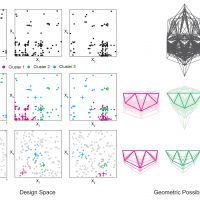Tag: design-space
-
 PlumaDesign, 2020
PlumaDesign, 2020With a design framework applicable to any site in the world, the Pluma installation envisions a lightweight future where structures generate more energy than they embody. Earned honorable mention at the IASS 2020 Design Competition.
Pluma demonstrates how form can follow function across disciplines and performance metrics. The design features photovoltaic membranes suspended in a lightweight cable system, resembling a flock of birds in flight.
The shape and orientation of the membrane ensemble is precisely tuned by an optimization algorithm to maximize solar radiation exposure and power generation on the site in Surrey.
Its supporting frame consists of standard timber elements assembled into cruciform sections, with simple, repeated connection details that are cost-effective. The foundation is a concrete slab hollowed out with compressed sawdust blocks as lost formwork, reducing the embodied energy compared to a typical slab by half.
-
 Integrated design for greenhouse in Portola ValleyDesign, 2018 - Present
Integrated design for greenhouse in Portola ValleyDesign, 2018 - PresentThis ongoing design project looks at an "eco-modernist" custom greenhouse to be built in Portola Valley, California. The objective of this greenhouse is to meet requirements for extended-season plant growth while requiring limited intervention for operation and applying approaches of structural efficiency. Tools such as our Design Space Explorer suite are used to explore and select among a wide design space that meet performance objectives to varying degrees. Local materials and custom structural joinery will be used in the greenhouse construction.
-
 Designing with data: moving beyond the design space catalogNathan Brown and Caitlin Mueller, ACADIA, 2017
Designing with data: moving beyond the design space catalogNathan Brown and Caitlin Mueller, ACADIA, 2017Design space catalogs, which present a collection of different options for selection by human designers, have become commonplace in architecture. Increasingly, these catalogs are rapidly generated using parametric models and informed by simulations that describe energy usage, structural efficiency, daylight availability, views, acoustic properties, and other aspects of building performance. However, by conceiving of computational methods as a means for fostering interactive, collaborative, guided, expert-dependent design processes, many opportunities remain to improve upon the originally static archetype of the design space catalog. This paper presents developments in the areas of interaction, automation, simplification, and visualization that seek to improve on the current catalog model, while also describing a vision for effective computer-aided, performance-based design processes in the future.
-
 Automated performance-based design space simplification for parametric structural designNathan Brown and Caitlin Mueller, Proceedings of the International Association for Shell and Spatial Structures (IASS) Symposium, 2017
Automated performance-based design space simplification for parametric structural designNathan Brown and Caitlin Mueller, Proceedings of the International Association for Shell and Spatial Structures (IASS) Symposium, 2017As computation has advanced, more designers are becoming familiar with parametric and performance-based design space exploration, techniques that can provide feedback and guidance even in early-stage design. However, two downsides of such techniques are the time and expertise required for problem setup, and the potential of the large volume of generated data to become overwhelming and difficult to absorb. Researchers must find ways to organize performance-based information and simplify exploration so that the design process is more manageable, while ensuring that performance feedback leads to better outcomes. This paper proposes two new applications of traditional optimization methods that can help simplify early-stage architectural or structural parametric design. The first involves analyzing the design variables considered in the problem, ranking their importance, and determining which ones should be eliminated or emphasized during exploration. The second method clusters designs into families and enables designers to cycle through these families during exploration. Two structural design case studies are presented to illustrate the possibilities created by variable analysis and clustering in conceptual, performance-based design.
-
 High-dimensional design space visualization for conceptual structural designCaitlin Mueller, MIT SM Thesis, 2014
High-dimensional design space visualization for conceptual structural designCaitlin Mueller, MIT SM Thesis, 2014This thesis focuses on visualizing high-dimensional design spaces for early-stage design problems in structural engineering and related disciplines. The design space, which is defined as the n + 1-dimensional surface that relates n design variables to a performance metric, contains all possible solutions to a formulated design problem. Graphical views of the design space are highly useful for designers because they organize a wide range of design possibilities in a compact, intuitive, and logical manner, illuminating global patterns, variable behaviors and relationships, and the nature of paths taken during iterative design processes. Design problems with two or fewer variables can easily be visualized in Euclidian space, through a curve or surface, but high-dimensional problems are difficult to display graphically. This is the key challenge addressed in this thesis. The thesis includes a critical review of existing methods for high-dimensional design space visualization, highlighting the unmet needs across a range of approaches. In response to these needs, the thesis makes a key contribution in the form of a new design space visualization method, called isoperforming parallel coordinate clusters (IPC clusters), that overcomes the issues of previous techniques. The IPC cluster approach is demonstrated on several conceptual structural design problems, and its application in optimization, directed exploration, and related design strategies is illustrated. Finally, the thesis concludes with a discussion of applications, impact, and future research directions.
-
 Quantifying diversity in computational designResearch, 2015 - Present
Quantifying diversity in computational designResearch, 2015 - PresentTo be useful for architects searching for creative, expressive forms, multi-objective optimization tools must generate a diverse range of design solutions. This gives the designer flexibility to choose from a number of high-performing designs based on aesthetic preferences or specific performance priorities. However, there is no single established method for measuring diversity, and no explicit understanding of how greater optimization output diversity leads to better architectural outcomes. This research project explores different metrics for quantifying diversity and tests how users interact with design processes that employ various diversity measurements.


